Developer: Piranha Bytes | Released: 2014 | Genre: RPG, Third Person
I decided to round off with the third game in the series now that I was on a roll anyway. Again, it was from Steam and included all DLC. This played like the quite the best game of the three. Yes, it reused a lot of assets and ideas from the second game (which probably also explains the development gap of only two years) but it felt more refined and it also grabbed me a lot better in the beginning, especially because I visited Fog Island first where plain old exploration was in the lead.
The game was more colorful and overgrown than ever. Truly Caribbean “Bounty”-land and lots of weird plants. For some strange reason the guy in my control was now Patty’s brother, without any explanation about what happened to the previous nameless hero with the eye patch. Maybe they simply didn’t want gamers to see that eye patch anymore? Alas, the siblings really left a skewed first impression. Patty now looked like a porn star with tits right in your face. I love tits as much as any man, but her outfit was really ludicrous. Similarly, the new nameless hero had a deep and dry voice that was just contrived.
I was already missing “John” and his normal voice. Two games and he was out.
The human models were much better now and added a lot to the overall impression. Eyes now moved properly to the sides, lip sync was slightly better, and although gesticulations were still a bit exaggerated, they seemed more focused now. Dialog was the same old. It still had that feeling of superfluous information that I often had to skip to get to the point, or maybe the interlocutor passed that point long ago and just kept on blathering anyway.
I’m not sure I’ve seen so much recycling between major versions of a game in an RPG franchise. We’re not just talking about graphics and rules. Some sound effects were exactly the same. The full screen UI panes were clearly just tweaked a little and still working in much the same way. Same inventory listing, same style of tabs in the top, same way all food became provisions. Same way chests and corpses were looted, same glory (XP) system only with a few more skill branches. Same jumping to ledges. Almost the same combat with dodge-rolling. And how firearms showed an orange circle for precision.
And exactly the same lockpick minigame.
But if it’s not broken there’s no need to fix it, and it obviously made it possible to refine a lot of stuff. The UI was sensibly improved here and there. Quests could now be marked on the map to show a red cross, and the minimap (a first in the series) showed a red arrow to it in the edge (just a shame the minimap was zoomed in way too closely to be of much use). Quicksaves were now three files in a rotation instead of testing the limitations of my local storage system.
I imagine that reusing a lot of this stuff also opened up for things not normally feasible in a tight development schedule. It was now possible to swim around in lakes and rivers, for example – another first in the series. There was the same black screen and setting back 10-20 meters when trying to leave islands, though. Soul points now served as a morale compass in dialogs, much like in BioWare games. Astral vision was added as a color filter (a feature I constantly forgot about). Sleep sometimes invoked small dream sequences, and there were a lot of new minigames as well.
Where a lot was changed between the first and second game in the series, I was happy I played this third game in the series right after the second one. Islands were a mix of old and new, and the old ones had much of the same layout intact – especially towns. A lot of the past history and returning NPC were often referred to in dialog, and it was great immediately knowing what they were talking about.
Going into details, I can mention that it was now possible to drink from water barrels again, just as it was in the first game. Thunderstorms were less annoying than in the first two games as it was now mostly a rumbling in the distance. And torches were no longer necessary in caves and dungeons since they were now somewhat brighter – perhaps because of adding new kinds of lighting available in 2014?
Apart from lockpicking, the drinking game and pickpocketing (which now allowed me to try with too low a score and thus get pummeled) were also largely unchanged. The QTE traps and being pushed on my back by a predator were also still there. A new one was arm wrestling. I had to match direction keys in the edges of the screen, then mash the final key to top it off.
Knife throwing had two parts. First I had to line up the knife against a round target with numeric fields. A bouncing bar then showed up in the side and a click froze it, throwing the knife higher according to the bar. The bouncing effect was quite fast, so it wasn’t too easy.
It was now also possible to use a magical scroll to turn myself into an extremely blue parrot. Reviews said it was great for scouting out an island from above, but it actually reminded me a lot more of the levitation spell in the first game. A slight gliding downwards, with a key held down to gain height but also drain a yellow bar. Great for reaching ledges normally out of reach.
As soon as I had joined a faction, I got access to a real pirate ship instead of the small sloop I was using in the beginning. This also made various kinds of sea battles available.
The first type I tried was against an enormous sea monster. Probably a parent to the one that used to guard the beaches in the first game. I could sail around, avoiding rocky islands, shoot to the sides with cannons that rarely hit it, then actually hit it with a front cannon that I could aim in first person. Although well done, it had too many idle passages and took too long.
But only the first time. The next two battles were surprisingly short. Maybe I just got lucky?
The second type was being boarded by an enemy pirate ship. Lots of chaotic fighting all over the place. Some pirates brought in bombs with fuses and I had to defeat them fast so I could haul the bombs overboard. After three repeats of this, the surprisingly easy captain was killed. At this time I had offensive magic spells. That might explain why he was such a pushover.
The layout of the islands was also much the same as in the previous game. Relatively small islands with areas and ravines surrounding by big masses of mountains. That doesn’t mean they were not fun to explore. There was still a lot to see and find, and the connectivity was okay. But just as the new minimap was zoomed in too closely, the separate map function now had a zoom functionality too that was zoomed in too closely by default. I always had to zoom it out before I could get my bearings.
I mentioned the ability to mark a quest target as a red cross on the map. Another change was teleporters and their stones. Teleporter stones have to be found as loot, and a teleporter could then be activated with a stone after which it lit up and was now available on the map. In the second game, travel points just appeared as big circles upon visiting the area for the first time. Luckily teleporter stones turned out to be relatively easy to find, so it was not an issue. In fact, finding the actual teleporters themselves was often much more aggravating.
Most of the islands had gray, swirling areas on the map, and entering these areas completely transformed the look into an ash gray and ominous setting. This was backed up with a terrific ambient soundtrack and the overall atmosphere was very convincing. It was always swarming with shadow monsters such as skeletons, minions, hellhounds and shadow lords.
Although also polished a bit here and there, the combat system was virtually the same as in the previous game. Blocking with the blade seemed to work better, but again dodging was the thing I used the most in close combat. A lot of animals in the game have the clairvoyant ability to attack me a few microseconds before I decided to do the same thing – at least it often felt like it. Especially scavengers and dragon snappers were infuriating adversaries, and they could rub my nose in it by now also smacking me flat on my face with a big crash.
Ironically, the biggest enemies were much easier to deal with, and for some reason humans and skeletons were also easier than they used to be. It was those scavengers and dragon snappers that made me sigh the most when I caught sight of them.
In the beginning it was only when I was fighting together with a companion that it went well. In the tutorial it was Patty, and on the first couple of islands it was mostly Bones, the crazy doctor from Maracai Bay back in the second game. As long as the companion was there to tank for me and there was only one single enemy, I could always exploit the combat system in the following quite satisfying way:
- Roll around the enemy until the companion hits it often enough to grab aggro (a hit or two).
- Run up to the enemy and perform power attacks (hold attack button until my hands glow).
- When aggro shifts over towards me, go back to step 1.
This exploit worked against pretty much all enemies I met until I got my hands on magic, but if there were more than one enemy I had to expect getting slapped around a bit. To be honest, while close combat was indeed better, it still needed a lot of work.
Another problem was that I sometimes jumped up or down from edges to cut corners, and the companion AI didn’t always catch up on this. Sometimes they even got stuck in a way that started bumping the frame rate down, as if the AI coding bogged down figuring out how to guide him or her further. I could go on for a long time alone that way, making close combat harder than it had to be. A fix was to use one of the transporters on the map – that usually brought my companion along as well.
For some odd reason, the AI getting stuck seemed to be especially bad on Fog Island.
Getting access to offensive magic was a long and arduous quest road on Taranis, home of the mages. As soon as I got access to offensive spells, things got quite a bit easier – just as I had hoped for. Initially, it even felt too good to be true. No mana? Small cooldowns? What is this, cheat mode? Yet the fastest enemies still managed to run up and repeatedly interrupt me, and thus the tank exploit was sometimes still useful.
If I held down the right mouse button, i could spam the spell faster than usual in a first person view, but then there was no auto aim. With just the left mouse button, the hero had to animate some gestures for firing the spell and this made casting slower. Holding down the left mouse button launched the most damaging spell of all, but I had to make sure of a bit of distance or a companion tanking for me.
Later, I bought an AOE spell to rain fire on a group of enemies, but the damage was low enough for it to not feel overpowered, and it also had a long cooldown.
There were a lot of support spells, either as scrolls, rune stones or additional crystal magic. Apart from obvious ones such as draining health, PBAOE damage, summons, shields and weaken, there was bloodlust for making enemies attack each other. I also had crystal magic for opening locks, and telekinesis.
The game started with me as a pirate captain on a ship being boarded. I’ve never been fond of being thrown into lots of chaotic fighting without knowing anything about the controls and my abilities, even if tutorial tips fly up on the screen one after another. I don’t know why game developers always think this is such an awesome idea. Maybe it’s part wanting to grab the player right from the start, part wanting to show how powerful you can become later.
And it was even only a dream sequence.
It was followed by a tutorial on The Crab Coast together with his negging sister Patty and her ludicrous porn outfit. We found a crystal portal and the nameless captain had his soul sucked out by a shadow lord. Apparently it killed him. He was even buried and all.
And Patty cried at his grave. How about that.
The second companion, the crazy doctor Bones from the second game, arrived some time later and revived the captain with voodoo magic. The nameless captain now had his soul in the Underworld and had to retrieve his humanity. Every time I slept (mostly to get rid of having to endure night time) there was a chance i was dreaming too. Luckily these sequences were always short. I barely collected some soul dust or I talked to a ghost that was once alive in the earlier games. Mostly this was one of the enemies that the previous protagonist “John” had killed in the second game.
Bones was my only companion for a long time and had a peculiar waving voice that took some time getting used to. Sometimes he could use a healing spell in combat, but I think I only saw him actually using it twice or so. He also had a small sloop, and from that point on I could choose freely among half a dozen islands as my next destination.
I chose Fog Island first because I had read that it had a legendary item giving 10% additional glory (XP) so it made sense to get that as fast as possible. I also liked this island because it had few NPC and a lot of exploration. And it was part of a DLC too.
The few NPC it did have were mostly Inquisition. Venturo was one of them – the red-headed guy that was part of the ship crew in the second game. Here he was only a quest giver. He had a small gold pouch conspicuously placed near his own jewels. I can only imagine the hurt he must have gone through when running away from enemies.
Rock, Paper, Shotgun also had a lot of fun with this pouch.
There were five soul eaters on the island that had to be killed. Some were masquerading as something else. One was resembling a lady that two men were quarreling about, and in another area two men were obsessed with killing ducks – one of which indeed turned out to be a soul eater.
Antigua was the next island I visited. It was also in the second game and a lot was recognizable. Especially the town. It was swarming with hellhounds to begin with, but soon after killing them I had a talk with Admiral Alvarez. He was still living in the exact same building in town. Alvarez suggested creating a fleet of ships by joining forces with other factions, and that broadened my adventures a bit.
As my next choice of island I wanted something new, so I went with Taranis. Another reason was that I wanted to get access to offensive magic now that it was available again – magic was banned in the second game and I had to settle with muskets there. But just as in the first game in the series, it took a lot of quests and adventuring to gain access to spell training. Four mines had to be discovered or cleansed of enemies, and I had to find and activate monolith stones for a “reactor” that actually just looked like a plain boss arena. Another problem was that the mages weren’t exactly the most friendly in the game.
But I persevered and eventually got access to offensive magic spells. The ironic thing was that when I did, the entire island had been cleaned out of enemies (except one) and I had to go to the next island to try it out against the usual palette of enemies. But the good news was that joining up with the mages also gave me access to their ship. No more “slooping” around.
The mages on Taranis employed gnomes as workers, both in mines and at their HQ, and they too had various quests. Mostly about finding lost fellow gnomes. In the southwestern corner, inside a small swamp, I met Shax – a borderline shadow minion that still had a smattering of sanity left. He joined up as my second companion for quite a while. Together we all cleaned out the shadow area close by.
I also met the ghost companion Mendoza but I barely had him on my mage ship for more than a few minutes. I had been doing primarily good deeds and my soul rating was way too high for him to accept. So he left. Luckily there were plenty of other companions. On Antigua I met the Demon Hunter (but casually dressed) Edward, and on Taranis I even found the funny gnome Jaffar from the second game. He was still wearing Steelbeard’s hat.
And he was still cursing like a genuine pirate captain.
Having Jaffar as a companion was great because of his hilarious comments, but he had another subtle ability no other companion had – he looted. In the beginning I thought it was annoying as I had to ask him to hand it over, but later I actually found it pleasant instead. It freed me from looting enemies that mostly only had crap anyway – or maybe I was rich enough to not care.
It was easy to accumulate gold now. Much easier than in the first two games.
After my first battle against a sea monster I arrived at Tacarigua as my next island. It was another revisit from the second game, and again it was very recognizable. Same towers, same town, even Jack from the eastern tower – although now driven away by bullies. Commandant Sebastiano had gone too far and a few of his soldiers had deserted. I chose not to kill them for him. I even found the ex-governor Di Fuego, murdered with Sebastiano’s blade.
Most of the island was about exploration and killing a ton of monsters. In a swamp area to the far east I found a treasure hunter that promised finding a treasure with an enormous amount of gold. We found two chests. The first had a rusty fork, the second a hand mirror. And then his ghost father appeared and summoned him away as punishment.
I also found another companion on Tacarigua – the mage Horas. He was actually a bit boring, and he didn’t even use magic in fights. Just his blade. He accepted all rock crystals I found.
Leaving Tacarigua introduced me to the first real boarding battle between two ships. As mentioned earlier in the post it was a bit chaotic. The pushover captain was Morgan. I think I killed him in less than two seconds with a few lightning blasts.
After a small detour back to Taranis, I sailed to Kila. Another entirely new island. It was one of the big ones of the game, with pirates living by a broken ship by the beach and a clan of natives in a camp in the center, on several tall cliffs connected by suspension bridges. There was also a massive “King Kong” wall protecting a northwestern area that I couldn’t get access to on my first visit.
I even tried flying through an opening as a blue parrot. Invisible wall.
Among the pirates by the beach was Hawkins, the cook from the second game. He had gone somewhat bonkers, but he was cured after inviting all pirates to a talk around the campfire. This opened up for escorting a young native girl to their camp (her choice) and another companion got available – the drunk Saddec and his musket. Unfortunately, he was also boring. I only used him once.
And for crying out loud, Piranha Bytes introduced the extremely annoying Mud again. I met him near the wall and from then on he was my second companion, whether I liked it or not. Lots of stupid comments and no helping in combat. In fact, he often went down as I rained fire over several enemies and he did complain a lot about it, but that didn’t scare him away. At some point much later in the game, I fast traveled back to the ship from the northeastern island after meeting Patty again (standing conspicuously alone on a beach) and that seemed to lose Mud as the game didn’t allow him to come along on the ship itself.
What a relief – if only for a while.
The natives in the center of the island looked much like they did in the second game, and of course they had a lot of quests as well. I had to prove myself by killing a few named animals. Put in a good word for releasing a jerk with a death sentence. Use a voodoo doll to take over another native and say good things about the pirates to prevent a civil war. Gain a token of friendship for a woman to allow water carriers access to a pond. And a few more. Kila took quite a long time to get through.
There was even a rotating adventure puzzle that felt fiddly in a sloppy way.
After another detour past an earlier island, Isle of Thieves was next. It was swarming with both gnomes (friends) and goblins (enemies) as part of the second DLC. The gnomes had lost four auri culcis, which was obviously bad. A religious rule prevented me from just killing the gnomes before using stealth to get these without being detected. Luckily it wasn’t as annoying as it sounded. Most of the goblin camps around the island were very small and easy to sneak into. Each had the item lying on a table for me to grab.
And then afterwards I killed all the goblins.
Finally I decided to visit the last previously unvisited major area on the map, Calador. I arrived at night to a southern continent area secluded by mountains. Same size as the other islands. The local faction of Demon Hunters had lit a lot of green bonfires all over the place.
The Demon Hunters had a small citadel (not exactly impressive) and here I met the druid Eldric that had been a important NPC in all three games. But why on earth had the developers changed his appearance so radically this time around? It didn’t even make any sense! In the second game he had white hair and a great white beard, giving the impression of an old but experienced mage.
Now he was bald, had a smattering of a brown beard and thus gave me a completely different impression. He looked like a brute from a clan of bandits. It might as well have been a different guy.
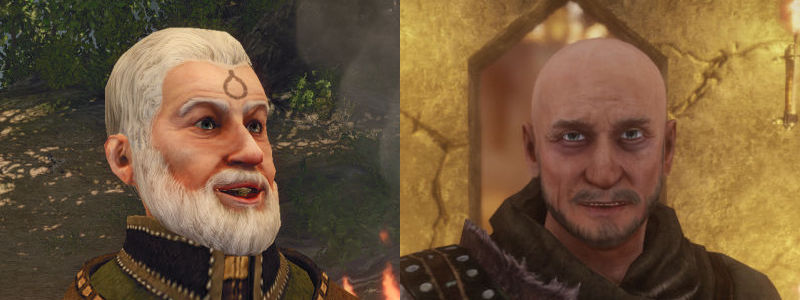
But Eldric did teach me how to destroy crystal gates. Awesome.
There was a lot to see and do in Calador. Again it was one of the larger areas in the game. Farmers wanting help, a local quest for my companion Edward to find his heritage, real tough shadow monsters, an eastern area I couldn’t access yet due to a river of lava and a broken bridge, and a really nice set of ruins to the west (although of course swarming with shadow monsters).
I went back and destroyed the crystal gates I knew about on the other islands, then returned to Calador and started the third chapter. Eldric and some of his Demon Hunters managed to teleport us to the eastern area across the lava. I found a powerful spell for a ritual and lit a tower beacon. Then together we all stormed several groups of shadow monsters and I destroyed another crystal gate.
But the most interesting part of this eastern shadow area of Calador was meeting the nameless hero from the first two games. It was awesome – I didn’t think they would do this. He was sitting by a camp fire with a bunch of dead shadow minions around him. We had a small talk. He was wearing casual clothes and looked a lot like he was in an idle mode. Now it was clearly my turn.
After I left the camp fire, I never saw “John” again.
The third chapter also opened up access through the gate of the “King Kong” wall to a forbidden valley. The really bad news was that Mud popped up on my ship as I arrived to Kila. I allowed him to follow me inside the valley and further inside a temple, and there he finally broke off and started collecting loot.
The valley was swarming with spiders. There was even an achievement for killing a ton of them. And there were a lot of tree trunks placed as bridges across cliffs. In fact, it was so overdone that it almost looked like a big grid in places. Chani was here too – the native female voodoo master that was a companion in the second game. Now she was also just a quest giver.
Far inside the temple in the valley, I fell through the floor and had a relatively short boss fight with the ginormous ancient spider queen Margoloth. No tricks here, I just shot her dry. She had long tubes of intestines all over her cave, some spitting out spider eggs. She agreed to be part of the upcoming ritual to repair the spirit of our nameless hero.
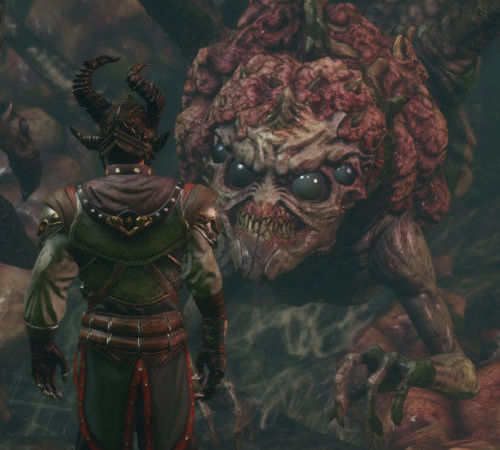
Getting out again was murder. It was by far the biggest dungeon of the entire game.
Back on Taranis the boss mage Zacharias finally emerged for the first time as the reactor below the bridge was activated. It still looked like nothing but a boss arena, and it would later turn out to be absolutely true. But for now, Zacharias led me inside a cave behind his house and proudly showed me an unactivated crystal gate. I tried to tell him what a mistake it was fiddling with this, but he didn’t believe me until it was turned on and it actually spit out a Shadow Lord with friends. And they were pissed.
Commandant Sebastiano became another boarding sea battle. Instead of bombs to throw overboard, the intermediate minigame here was using a cannon to pop soldiers on the other ship. It took some time as it actually wasn’t easy to hit the targets. And again, the commandant himself was kind of a pushover what with me casting lightning spells at him.
Having secured the support from all three powerful sorcerers in the game – the druid Eldric, the crystal mage Zacharias, and the voodoo shaman Chani – we all got together in Margoloth’s disgusting spider cave and began the ritual to repair my spirit.
It was a trap.
A new bad guy appeared, the ghost Nekroloth, claiming that the secret goal actually was to get all these sorcerers together so he could kidnap them. And indeed off they all want, in small green teleportation lights. Nekroloth left as well and the fourth and last chapter began.
In the meantime, one of my companions had betrayed me – Horas, the mage. He had left my ship and gone for the reactor to sabotage it by calling upon a big boss in it. So the reactor was indeed nothing but a boss arena – why was I not surprised. The boss in the middle of it could not be hurt with normal magic. Instead, I had to gather glowing shackled ropes and throw them at certain areas of the boss in a timely manner. He actually didn’t do much damage, but it still took a long time tying his limbs up with all of the ropes from around the edge of the round arena. Finally the boss was in shackles and it died.
Then Horas appeared afterwards. That fight was very short.
I gathered the ship support from all factions in the game, and Admiral Alvarez gave me the green light to go after the ghost captain Crow. It was another boarding sea battle and it was actually quite close to the dream sequence that introduced the entire game.
Recycling for the win.
The defeat of captain Crow revealed the location of the hidden Skull Island, where I could find Nekroloth and the three kidnapped sorcerers. Just like Maracai Bay in the second game, I was impressed how much there was to do in this late game area. There were quests here and there, like securing several weapon depots, finding out how to make an invulnerable ghost mortal, and of course freeing each sorcerer from their magical shackles in three big areas in each corner of the island.
And to top it off, the island itself was quite big and swarming with shadow monsters.
The first sorcerer, Zacharias, was found in a broken bridge building towering way up across the first landing camp. Eldric was found in a crystal cave in a secluded northeastern peninsula. And Chani was found in a dungeon with rotating bridges and levers. This part actually smelled a lot like the developers had one of the first Tomb Raider games in mind.
Her area also had two more of those rotational adventure game puzzles with three rings, for opening a few gates to more loot. I really didn’t like it – I thought it was poorly done. It felt way too fiddly the way the rings took some time before they stopped, like they were too oiled or something. As if it was asking to be brute forced but simultaneously also punishing it.
And then finally, because all three sorcerers were now free, I could join up with my ghost self – only to have it ripped from me again in the beginning of the boss fight against Nekroloth. He turned into a Titan Lord, crawling up from the ground, and he tried to suck the spirit out of my physical, unconscious copy. As the ghost version of myself I had to interrupt him by doing damage with my usual spells.
Sounds easy, right?
There were a lot of crystal gates all over the cave, and a ton of shadow monsters spawned out of them to join their master. They interrupted a lot of attempts to blast at Nekroloth, and to make matters even worse he sometimes fled through a gate holding my alter ego in his arms. I then had to run after him through the same gate to another part of the cave, all while I was still being pummeled in my arse by hellhounds and minions and spirit eaters.
It’s not even that I took too much damage. I could keep it up with my enormous stock of health alcohol and provisions. It was just such a stressful and draining battle. Nekroloth had a ton of health, the other shadow monsters got in my way while attacking, and he kept running away through yet another crystal gate.
When he finally bit the dust, I felt like I had endured a training program to lose weight.
The ending was very abrupt. I barely merged with myself, met with my companions in a short cutscene without dialog, and they left the island on the ship. The end. The second game had some final talk with the companions like in a BioWare game, but this apparently had to be cut out this time around.
What a shame.
Remember how i was wondering about the nameless hero from the first two games having been replaced with a previously unmentioned son of Steelbeard?
Well, I actually have a theory about that.
When I joined up with the mages, they gave me not only a new set of armor but also a prism for one eye, to expand the astral vision. My theory is that the developers didn’t like the look of the hero from the second game wearing this on one eye and the eye patch on the other. It would have made him look silly.
Or maybe they just really wanted to have that deep, dry and terrible hero voice.
| TitleLength | Dates | Diff / Cht | Save | Score | |
|---|---|---|---|---|---|
|
Risen 3: Titan Lords
2014 Piranha Bytes38h 30m 11
|
2016-03-13 2016-03-27 |
9
|
|||
|
Risen 3: Fog Island
2014 Piranha Bytes
|
|
|
|||
|
Risen 3: Uprising of the Little Guys
2014 Piranha Bytes
|
|
|


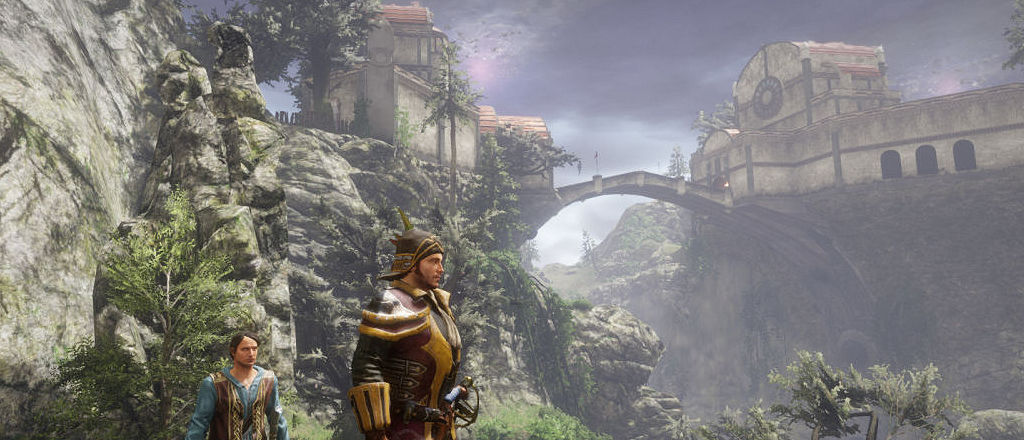
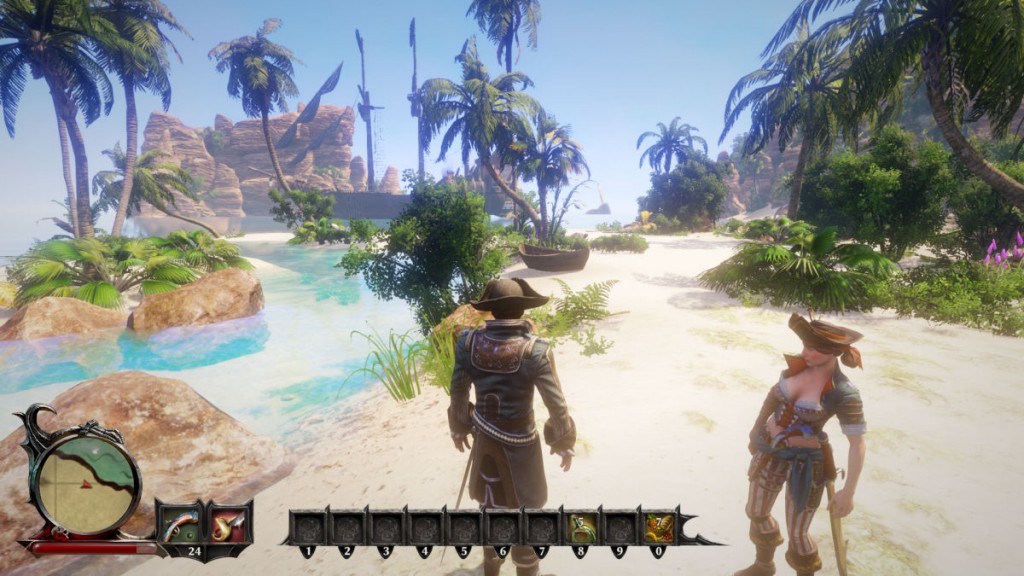
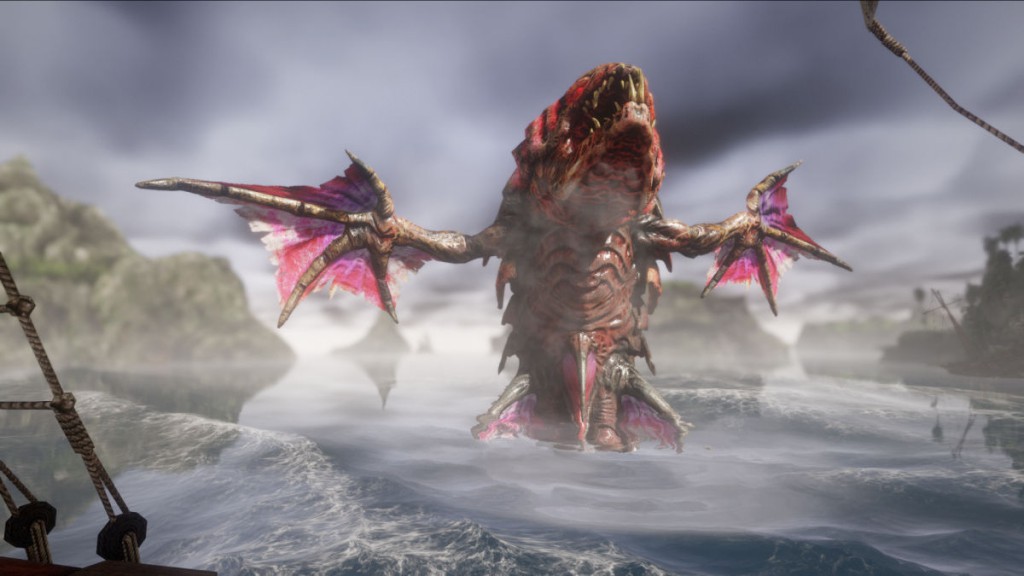
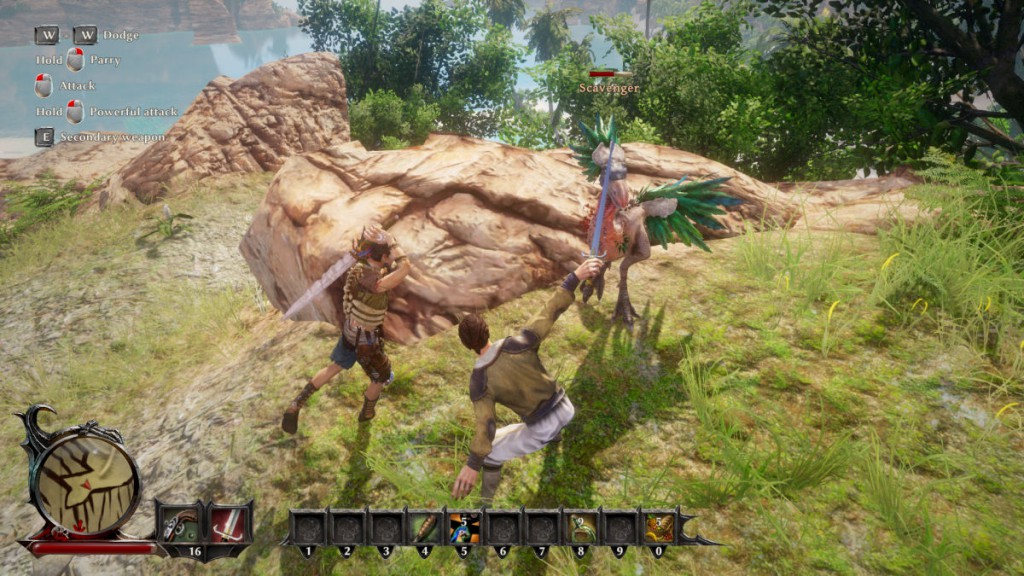
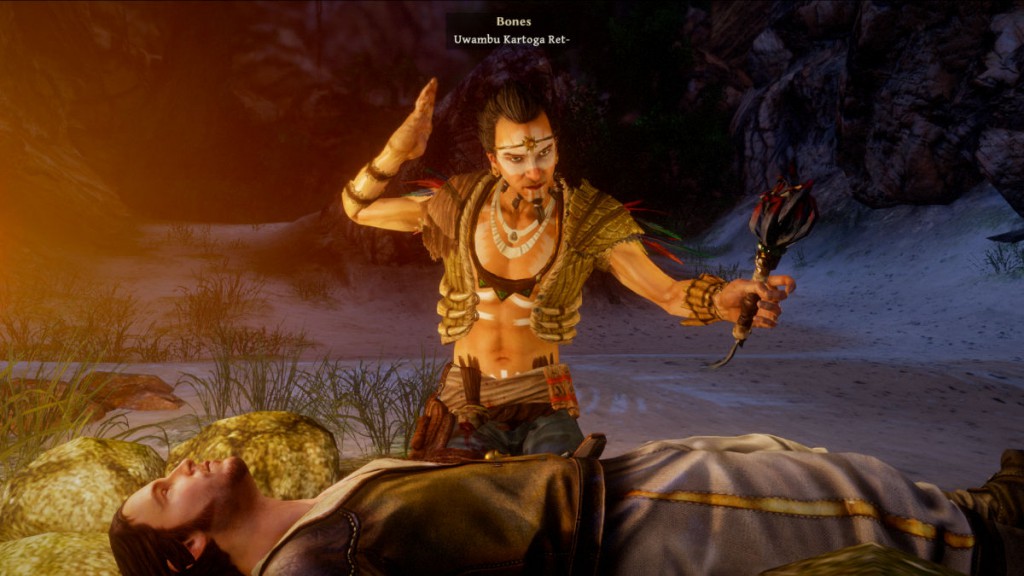
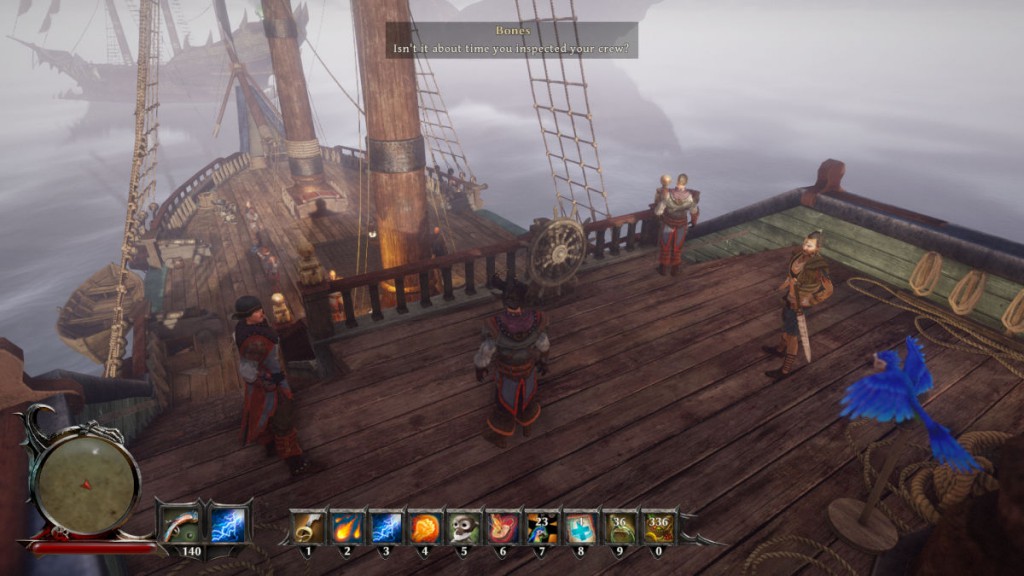
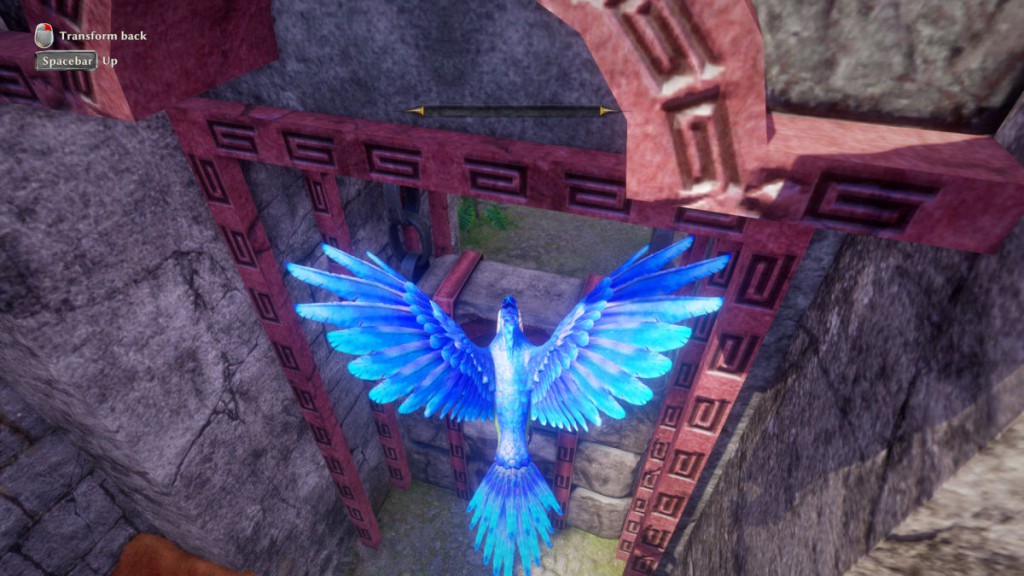
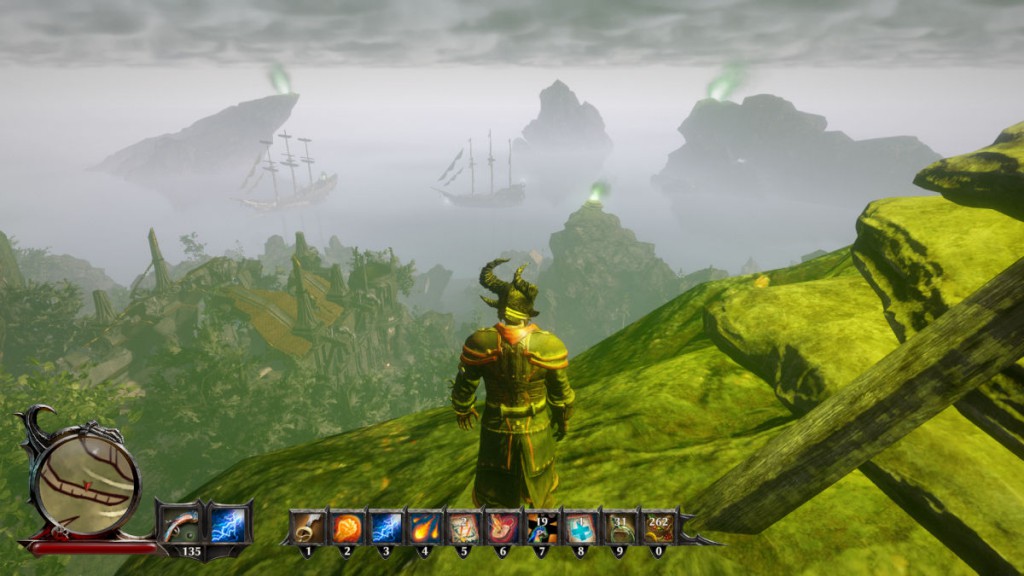
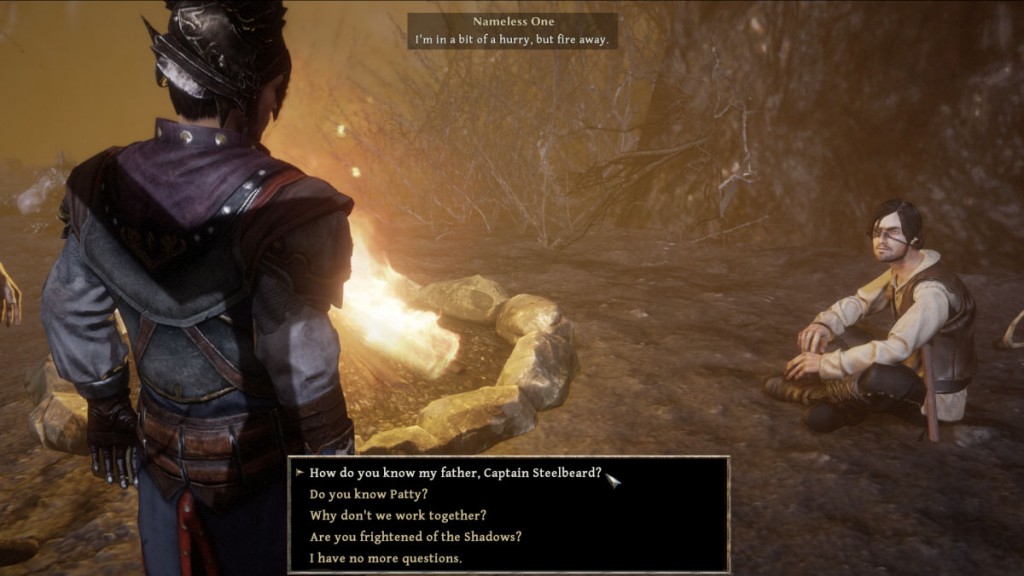
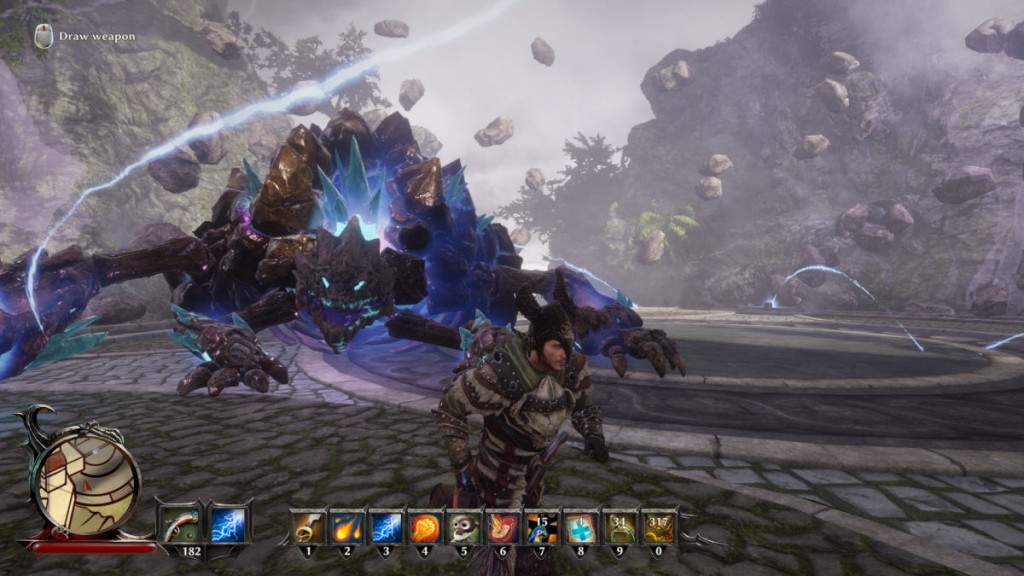
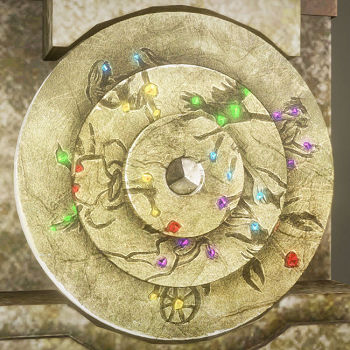
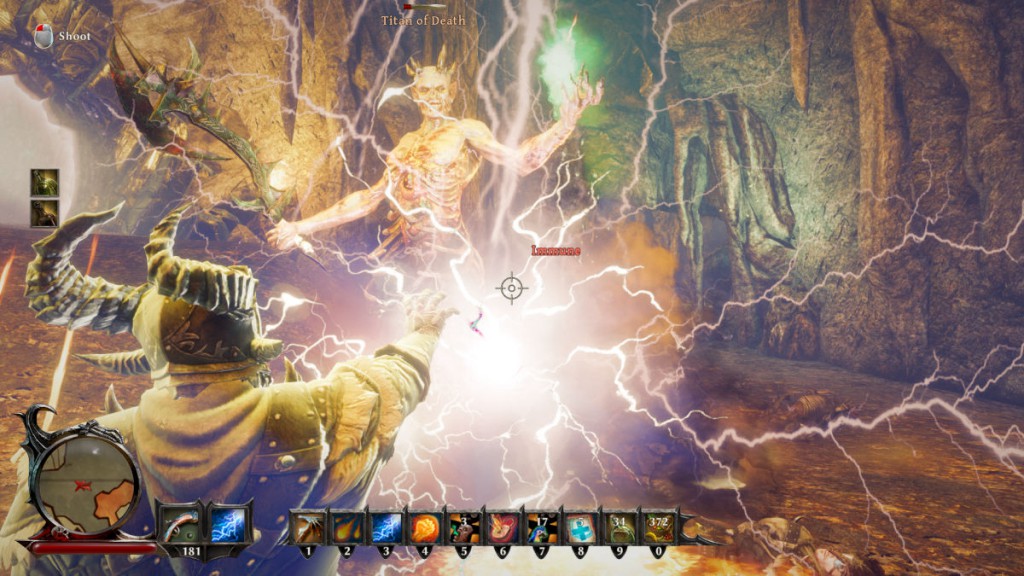
First off; you really shouldn’t talk about a character looking like a porn star and then forget to add a good screenshot of her ;). Secondly; if I was curious to play the Risen games, would you recommend playing all three or just some/one of them? It seems like a lot of story carries on through all three games, but the downside seems to be that the UI is rather clunky in the earlier ones?
Check out my blog post with the profanity gallery. The last screenshot there is a really good picture of Patty saying something quite relevant. 😉
If you want to choose only one, I can really recommend the third and last Risen in the series which I thought was the best. Most polished, refined, prettiest, etc. It’s true you’ll lose out on a lot of references to earlier games, but look at it this way – the new nameless hero in the third game is just as much in the dark as you are.
Yeah, read that one after commenting here; still, that screenshot should’ve been embedded in this post ;). My question wasn’t really which game I should pick if I wanted to play only one but rather is it worth playing more than one of them? So, would you say that suffering through the less refined (would you even call it suffering, or isn’t it THAT bad?) early games is worth it for their story & getting a better story as a whole? Or just jump to the newest game and still getting a decent story?
After your comment I added a hyperlink to the image. It’s so over the top I actually hesitate to post a big screenshot in this blog post. 😀
I liked them all three and don’t regret playing through them, back to back. At GameDeed.com I gave them 8, 7 and 9 (out of 10) but even the second game had a lot to like, in spite of it completely throwing magic out of the window (which did disappoint me a bit).
I’m sorting my screenshots from all three games at the moment with the intention of writing a blog post comparing various stuff across them, and it hit me that a lot of locations and NPC were actually first introduced in the second game. I think it would be perfectly possible to start with the second game and still be on top regarding most of the Risen story. There’s also quite a jump in graphics quality from the first to the second game – another good reason to start there.
Looking forward to the comparison post, it could become quite long if you include everything from characters to graphics, user interface to continuity and combat mechanics to game specific frustrations 😉
Funny you mention it. 😀
I started sorting yesterday and before I knew it I had a zillion sub folders. I wanted to get all screenshots sorted but it took a couple of hours just for the two first games alone. Each had about 700 screenshots.
I took over 1200 screenshots for the third game.